How to make a water pipe in the country with your own hands: the rules for laying, installing and arranging
Leaving for the country outside the city, few people are ready to completely abandon the benefits of civilization, especially when it comes to water supply. Agree, the importance of water supply of a summer cottage is difficult to overestimate.
Water is necessary for watering the garden and garden beds, as well as solving everyday problems. What can we say about the use of household appliances requiring connection to the water supply network. To equip water supply, you can attract specialists or do it yourself.
To make the water supply in the country with your own hands, you first need to determine the source of the water, select the necessary equipment and materials, study the sequence of work. These are the questions we will help you solve.
For a better understanding of the water supply process, we illustrated the material with visual diagrams and photographs, supplemented the information with video clips.
The content of the article:
Water intake selection
The device of any water supply system begins with the choice of a source of water supply. Although the choice is usually not great. It can be a centralized water supply system, well or well.
Not only its quality depends on where the water will come from, but also the ways of arranging the entire water supply system, its technical complexity and cost.
Option 1. Water from the well
The simplest "grandfather" method is dig a well. Its depth depends on the occurrence of the aquifer - up to 10 - 20 meters, as a rule. Of course, you can use such water only if filters are installed. Water in wells is often contaminated with nitrates and heavy metals.
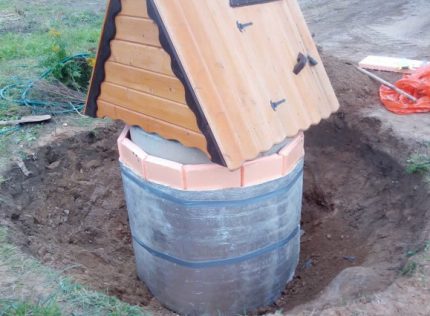
Option # 2. Water well
The best option is equip a well. Here one can not do without special equipment - you can’t drill a well with a shovel. The main advantage of such a source of water supply is clean water.
The depth of the well for a private house starts from 15 m. At this depth, the water is not contaminated with nitrate fertilizers, domestic wastewater and other agricultural wastes.
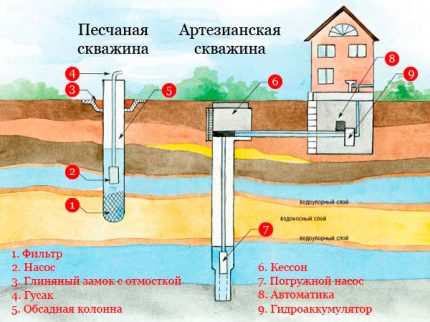
Drilling a well will cost much more than digging a well, and servicing it is not easy: constant cleaning, maintenance, and flushing. But 1.5 cubic meters per hour, which can be raised from the well, provide almost unlimited consumption of clean and fresh water.
Option # 3. We are connected to the central water supply
If a centralized water supply system has been laid near your site, you can connect to it. Among the advantages of this option, constant pressure and water purification are distinguished. However, in practice, the pressure often does not meet the standards, and there is nothing to talk about cleaning.
In addition, simply connecting to the pipeline will not work for you - it is illegal. We’ll have to write a statement to the water utility, provide a site plan with all communications, draw up project documentation and obtain permission from the sanitary and epidemiological station. The whole procedure is stretched for several months and flies a pretty penny.
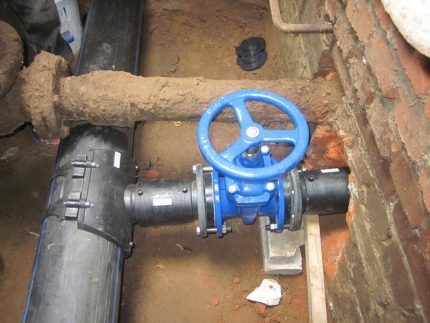
It is also impossible to use such water uncontrollably, you will have to pay for each cubic meter used at the established tariff.Based on all of the above, not only many summer residents, but also residents of private households make their choice in favor of drilling wells in their area.
Winter or summer water supply?
Depending on the cyclical use, there are two options for the water supply scheme:
- all-weather (winter);
- simplified (summer).
If your site is used exclusively in the summer season, that is, from spring to autumn, it simply does not make sense to spend money on expensive capital water supply. In this case, there can be two options - collapsible water supply and stationary.

The first is very convenient in that at the end of the season all hoses can be removed and stored. So they will not deteriorate from the cold and will last longer. To lay such a water supply you do not even have to use a shovel - all communications pass on the surface.
You’ll have to work a bit with laying summer water stationary type. It also does not imply the presence and installation of complex equipment, but differs in that the pipes are underground and cannot be removed for the winter. Collapsible cranes are brought out in the right places.
The main condition is to completely drain the water from the system for the winter so that at minus temperature the frozen water does not break the pipes.
A summer water supply will be quite enough for basic household and agricultural needs on the scale of one summer cottage. But if you are accustomed to comfort, use the cottage as a place to relax and want to use water as well as at home in the city, then it is better to do it in the country winter version of the water supply.
Winter water supply - the system is much more complex. Everything must be taken into account - from the natural slope of the terrain to the depth of freezing of the soil. A pump is required to ensure water pressure. In a word, a country-type water supply system of a winter type is no different from the water supply system of residential private houses.
Typical plumbing system design
The water supply at the summer cottage consists of several elements:
- pump equipment;
- pipes and fittings;
- pressure switch and pressure gauge;
- accumulator;
- device for draining.
In addition to the above, the system may include other elements, such as a storage tank, filters or heaters. Some components can be combined in one complex, for example, a pumping station.
Raise water from a well - pump selection
Water is supplied from a well or well by a pump. Choosing a pump is one of the most important tasks in planning the water supply of a summer cottage.
The choice of pump depends on:
- depth of a well or a well;
- volume of consumption;
- productivity of the well itself (debit);
- well diameter;
- water pressure;
- financial component.
Some of these parameters cannot be calculated accurately; an approximate estimate is made. To do this, it is better to consult with an experienced master, so as not to make mistakes.
There are two types of pumps:
- submersible;
- surface.
The surface version is used only for pumping water from a well. It can be placed on the surface or inside the well, but stay afloat. The maximum depth for which the surface pump is suitable is 8 m.
If your well is deeper or it is a well, then this is not the type of pump you are considering.
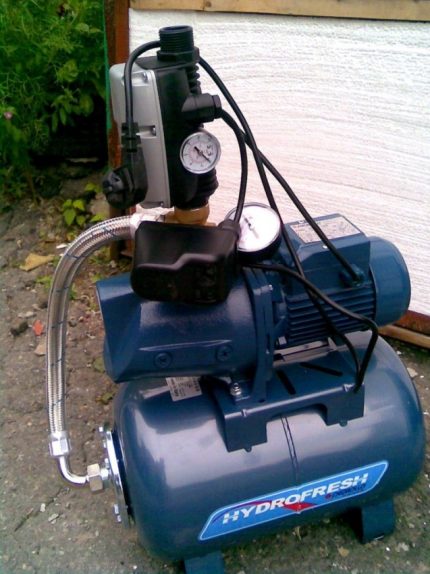
For wells choose submersible pumpswho are not afraid of water. Their advantages include low power consumption and quiet operation with a high level of productivity.
There are 2 types of submersible pumps, depending on the type of action:
- centrifugal;
- vibrating.
Centrifugal pumps pump liquid with blades. Under the action of centrifugal force, which occurs as a result of rotation of the blades, water enters the pipeline and moves along it.
These models are the most popular since centrifugal pumps combine: reliability, high performance and affordability.
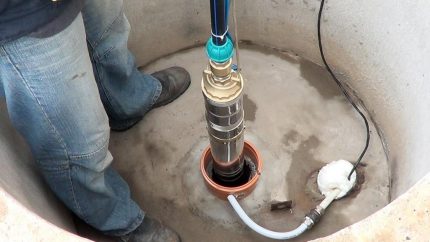
Vibrating pumps have a finely porous membrane in their structure. The fluid is pumped as a result of the difference in pressure from the deformation of the membrane.
Such a pump requires more thorough maintenance, the membrane may become dirty and malfunction. You can fix such a breakdown, but repairs or replacement will be expensive.
What pipes are suitable for country water supply
Water is supplied to the house and for household needs through a pipeline. Most commonly used are pipes with a diameter of 1 or ¾ inch.
Of modern materials for a country water supply fit:
- polypropylene;
- polyethylene pipes.
Each of the varieties has its pros and cons. So, polypropylene pipes more expensive than polyethylene. To connect them you need to get a special tool - a soldering iron or a welding machine for pipes.
But on the other hand, you can not buy a soldering iron, but rent it for the time of installation, but the savings on connecting fittings are significant, especially if the piping scheme involves a lot of branches.
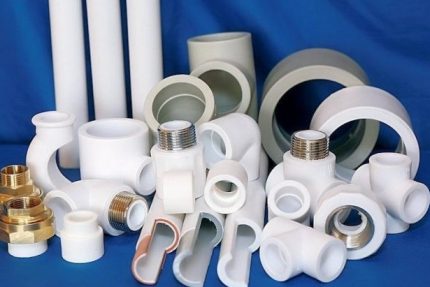
Polyethylene pipes are cheaper, but to connect them you need to buy metal elements, which in total are more expensive than the entire pipeline. And it is impossible to guarantee a completely tight connection, as when working with a soldering iron and a polypropylene pipe. Joints - a weak point of a polyethylene water supply system.
So that the winter water supply does not suffer from low temperature and does not freeze, you need to take care of the insulation of the pipeline. The modern solution is special tubular “covers” made of foamed polypropylene. Such a simple solution can protect your pipes from freezing and cracking.

Another option for insulation is a heating cable. It is laid parallel to the pipeline along its entire length. In the cold season, the cable warms the pipes and prevents freezing. But, of course, there are electricity costs to ensure constant heating.
Collapsible and stop valves
Water fittings are also of great importance. The reliability of the entire system depends on its quality. In the country kitchen, bath or bath, you can install ordinary faucets, but they are not suitable for installation on the street.
Outside, it is better to mount much more reliable and practical cranes with grandboxes or bronze valves.
The input dispensing unit is located on the surface, for example, in the utility room or in a specially designated place for it in the house. It includes a set of valves that cut off certain branchings of the system, a device for measuring, controlling and regulating pressure.
System pressure control
For comfortable use, the pressure in the system must be constant. The normal indicator is from 2.5 to 4 atmospheres. Not too low or too high rates are allowed. To control this parameter, the system is equipped with a special complex - pressure switch and accumulator.
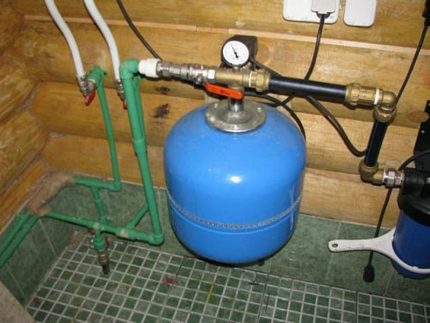
The accumulator is a tank that is filled with water from the system. A relay is installed behind the hydraulic tank. This device measures the water pressure in the system.
When it reaches the maximum allowable mark, the pump shuts off, and water continues to be supplied from the battery capacity. When the pressure stabilizes, the relay starts the pump again and fills the tank.
Another important device for the competent installation of the water supply in the country is a sensor for lack of water - a dry relay. It will shut off the system when for some reason there is too little water in the well and will prevent overheating and breakdown of the pump.
Water storage tank
The pressure in the country water supply system is provided with the help of a water tank. Its role, as a rule, is performed by a plastic barrel of large volume, located on an elevation. If there is a place in the attic - it is placed there.
If instead of the attic you have an attic floor, the water barrel can be placed on a specially built tower or overpass.
If the tank is located in an unheated room, and periodic residence in the country is planned in the winter, then you should take care of its insulation. This may be a protective structure insulated with foam or mineral wool.
The main thing is to carefully monitor that the tank is tight. Otherwise, particles of insulation, as well as dust and debris, may get inside and contaminate drinking water.
Drain valve for system conservation
There are situations when you have to preserve the water supply system, for example, during a long departure or repair. In such cases, all water should be drained from the system. For this, immediately after the pump, that is, at the lowest point of the system, a drain valve is installed.
If you turn off the pump and open the valve, the water will begin to move in the opposite direction through the pipeline due to the slope. Sometimes they act differently and install a check valve and a bypass pipe - bypass. This scheme is used when using water from deep wells and boreholes.
How to organize a sewer for water disposal?
Since there is practically no central sewage system in cottages, you need to take care of an individual solution for draining sewage and liquid household waste. In the old fashioned way, you can dig a cesspool, but this does not comply with sanitary standards. Yes, and you will have to clean such a pit often.
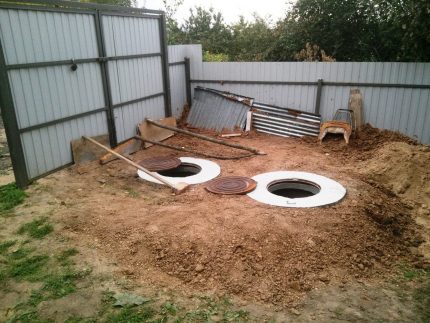
The modern solution is septic tank use. The simplest and most common way is a septic tank of 2-3 concrete rings. Although there are more advanced technologies, such as the Eurocube, for example.
The task of the septic tank is to separate the solid component of the effluent, and the relatively clean - liquid - to merge back into the soil. Thanks to such a system, it is possible to do with one call of the scavenger in several years.
Step-by-step installation guide
In order to independently build a water supply in the country, you need to carry out preparatory work: draw up a plan, prepare tools and materials. Only after careful preparation can you start laying the pipeline, connecting and installing the internal wiring.
Step 1. Action plan
You need to start work with a detailed plan. If the plan is complex, you can’t do without the help of a professional, because water supply is a responsible business.
If you decide to do it yourself, prepare all the information:
- soil freezing depth in your area;
- groundwater depth;
- relief slope;
- plan of existing communications with points of water intake;
- site plan with all buildings;
- the number of consumption points (water supply at home, baths, watering the garden, filling the pool, etc.).
First, draw a detailed diagram to scale. In addition to the usual terrain plan, draw a profile image of the pipeline and a plan in isometry. So you can take into account the slope when laying the water supply in the country.
If there is such a drawing, it will not be difficult to calculate the number of pipes and fittings. Never buy back-to-back material, make a small supply - about 10% of the total.

Freezing depth is one of the most important characteristics. It depends on how deeply the pipes will have to be laid. Please note that the depth of the pipe laying should be at least 20 cm greater than the freezing depth of the soil at the lowest point of the site.
Step # 2. Preparation of necessary tools
When the scheme is ready, the materials are calculated, you need to take care of the necessary tools. Suppose you already have a well or well, so you can skip the stage of their construction.
Tools for mounting a winter water supply in the country:
- shovel;
- adjustable wrench;
- gas key;
- welding machine for pipes - “iron” (when using polypropylene);
- roulette;
- pipe cutter;
- hacksaw;
- knife;
- gun for silicone and sealant.
Such a set will be enough for earthworks and plumbing.

If you plan to carry out electrical work yourself, then you need to expand the toolbox with a screwdriver, tester, wire cutters and other electrician tools.
Step # 3. Plumbing device
To properly organize the work, you need to know the correct order:
- Do excavation work. Armed with a shovel, take care of the device of trenches along the entire length of the water supply system according to the plan drawn up.
- Take care of pump power. It is necessary to dig a separate trench, lay the electric cable and mount the socket for connecting the pump.
- Install the pump. Depending on its type, it can be located outside or immersed in a well;
- Connect equipment to the pump: pressure switch, pressure gauge and accumulator. Then securely connect the pipe leading to the points of consumption.
- Install the drain valve for possible conservation of the system.
- Mount the piping system along the bottom of the trench. Do not forget about pipe insulation at this stage.
- Print the outside water points.
- Connect system and check its performance. Particular attention is paid to the joints of the pipes, as well as to the places where the equipment is connected.
- Fill the trench. They proceed to this stage if the system works stably and there are no leaks.
- Mount the internal water distribution.Plastic pipes do not rust, so they can be deepened into the walls. Install all faucets, plumbing, filtration systems and water heaters.
Water from the well must be cleaned. This is best done with flow filters or reverse osmosis systems. The latter provide complete purification from all impurities at the molecular level, but the cost of their installation and maintenance is much higher.
Step # 4.Choosing a device for heating water
To heat water in the country, you can use instantaneous water heaters (gas or electric) and storage type (boiler).
Geysers are very convenient, water is heated in unlimited quantities, quickly and efficiently. Yes, and you can save on electricity. But, firstly, the gas pipeline in the country is a rare phenomenon, and it makes no sense to connect a column to a gas cylinder, and secondly, the installation of the column should be done only by a qualified gas specialist.

Electric heaters can be installed and dismantled at any time, this is their advantage. However, in terms of heating rate, they are inferior to gas flow columns.
An electric boiler is the best option for use in the country. Hot water is always available, it is inexpensive and any beginner can install it.
Conclusions and useful video on the topic
In order to understand how to lay water supply in the country, look at these visual video tutorials. You will learn them of them, how to mount a water supply system from a well, a water well, and also how to make a summer version of water supply at a summer cottage.
Video review of laying a water pipe with a surface pump from a well:
Instructions for the installation of summer cottage water supply:
And this is an instruction for connecting all equipment - pressure switches, dry-running relays, etc.:
If you adhere to all our recommendations, you will be able to lay water pipes in your country house without the involvement of professionals.
Are you trying to independently equip a country water supply system or is there a successful experience in the implementation of water supply? Or maybe they do not agree with the stated material? We look forward to your comments and questions. The contact form is located below.

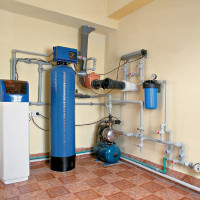 Plumbing in a private country house do-it-yourself: the rules of arrangement
Plumbing in a private country house do-it-yourself: the rules of arrangement 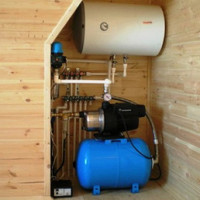 Do-it-yourself water supply of a private house: the rules of arrangement and the best schemes
Do-it-yourself water supply of a private house: the rules of arrangement and the best schemes  Do-it-yourself polypropylene plumbing: everything about installing a system of plastic pipes
Do-it-yourself polypropylene plumbing: everything about installing a system of plastic pipes 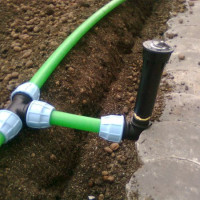 How to organize a summer water supply in a country house: laying and arranging a water supply for irrigation
How to organize a summer water supply in a country house: laying and arranging a water supply for irrigation 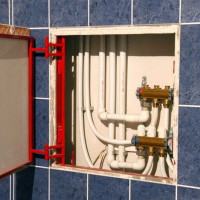 Water distribution in a private house: design rules + an overview of the best schemes
Water distribution in a private house: design rules + an overview of the best schemes 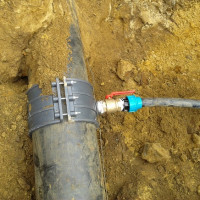 How to insert into an existing water supply system under pressure
How to insert into an existing water supply system under pressure  How much does it cost to connect gas to a private house: the price of organizing gas supply
How much does it cost to connect gas to a private house: the price of organizing gas supply  The best washing machines with dryer: model rating and customer tips
The best washing machines with dryer: model rating and customer tips  What is the color temperature of light and the nuances of choosing the temperature of the lamps to suit your needs
What is the color temperature of light and the nuances of choosing the temperature of the lamps to suit your needs  Replacement of a geyser in an apartment: replacement paperwork + basic norms and requirements
Replacement of a geyser in an apartment: replacement paperwork + basic norms and requirements
Everything is described, of course, very cool. This summer, they established water in the country. Dug a well of 7 rings. Plus bought a pump station. Personally, my opinion is: for a summer cottage this is an ideal option. We arrived, pumped out all the water from the well and started to pump clean water. The pumping station can be taken home for the winter. This is the easiest and cheapest option. I also want to buy shungite stones, like they also purify water.
Sewerage is the simplest: a pipe from a house to a garden. But, again, we have a summer option. For the winter, I would have laid pipes underground.
Hello. Unfortunately, the cleansing properties of shungite, like its price, are greatly exaggerated. Basically, it saturates water with globular carbon, the purifier from it is negligible. It is not for nothing that filter elements are always present in store filters with shungite, except for these stones, for example, activated carbon.
We had plumbing in our private house in the village. There is no central water supply or sewage system nearby, and I really wanted the amenities. We got out of the situation ourselves. We pump water from the river (it is about 100 m from the house) using a pumping unit. In the role of sewage, we have a buried barrel, there goes the drain from the toilet.We pass household water through two charcoal filters and pump it back into the river. For a year now the system has been working without failures, there is no smell in the toilet, pipes do not leak. A month ago, they called the sewers to pump out the drains from the barrel. We wash in the bath, in the old fashioned way. Water supply only in the house held.
There is no sense in insulating water pipes with thermal insulation. If you just lower the pipe below the level of freezing, but why then thermal insulation? Conduct an experiment - put a piece of pipe in this insulation with water inside in the cold. It will not freeze only if there is electric heating.
There is a sense to insulate, because insulation gives + to your depth, i.e. if the pipe is laid at a depth of 1 m - this is the freezing depth, and if the pipe is in the insulation, then consider that the pipe is at a depth of 1.5-1.6 m. Something like this 🙂 On the surface - that in the insulation that without it. But if they dug it, then this is approximately + 30-60 cm to the depth of the pipe.
Sani Sticks is an excellent assistant in getting rid of blockages and negative odors in the area of discharge and discharge into the drainage system.
Complexes of enzymes are concentrated in them, which improve and accelerate the processing of all types of organic deposits on the inner walls of pipes.
One package is designed for a year of use.
I want to share my experience in country water supply. Water is supplied from the well by a submersible pump through a ¾ inch PVC garden hose. The hose, without insulation and without heating cable, lies on the surface of the earth, partly underground at a shallow depth. I have been using this system for more than 10 years. And not once did the water in the hose freeze.
Because:
1). I punched a hole in the hose next to the pump with a 2 mm awl. When the pump shuts off, water from a hose through a hole slowly drains back into the well and does not freeze even in severe frost.
(Water also flows out through the hole when the pump is running, but this practically does not affect the overall performance).
Now, instead of a vibration pump, I have a centrifugal borehole pump. I screwed the outlet fitting to it without a gasket. The result is the same.
2). The hose along the entire length has a greater or lesser slope towards the well. Water in it should not be retained.
3.) Another prerequisite: the water inlet into the storage tank must be higher than the water level in it, otherwise with a pump not working, water will drain back into the well not only from the hose, but also from the storage tank.